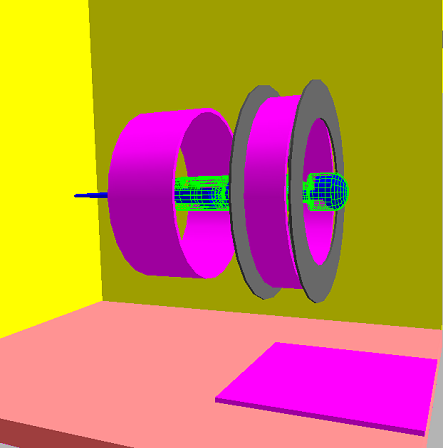
A MCNP model of a PET/CT scanner with a dosed patient in the scanner.
The vast majority of shield designs are performed by simple point kernel methods using the bulk attenuation properties of the shielding material and a known source term. All of the NCRP manuals use this method. However, when the geometries are complex (see above), or the shields are layered, the point kernel techniques perform poorly and can result in significant overshielding at great cost for the construction, or undershielding, requiring shielding retrofits, also at great cost.
For these complex designs, Monte Carlo (e.g. MCNP)or discreet ordinate (e.g. 3DANT or Mercurad) methods are preferable. While desirable, the implementation of these methods can be difficult. The three dimensional geometry of the shielded room must be described to the code, and the run times for Monte Carlo methods can run days to weeks before the results converge. Previously we have rented time on one of several supercomputers for these designs.
Recently, we have acquired two supercomputers from Thinkmate and Kingstar computers and have installed MCNP on them. With the new installations of these dedicated supercomputers, we have been able to completely eliminate the computer charge for advanced designs and have reduced the time it takes to perform the analysis significantly. This makes these approaches to shield designs far more affordable, and usable for smaller projects.
Areas where the Monte Carlo or discreet ordinate methods can contribute include facilities where:
- There is significant potential for streaming of radiation around barriers.
- Layered shields (e.g. Concrete over lead)
- Mixed field sources (e.g. protons, and photons)
- Multiple sources impacting a single area.
- Complex geometries where the source term is hard to define for point kernel methods.
Please call us for more information if these new capabilities could be of use to you.